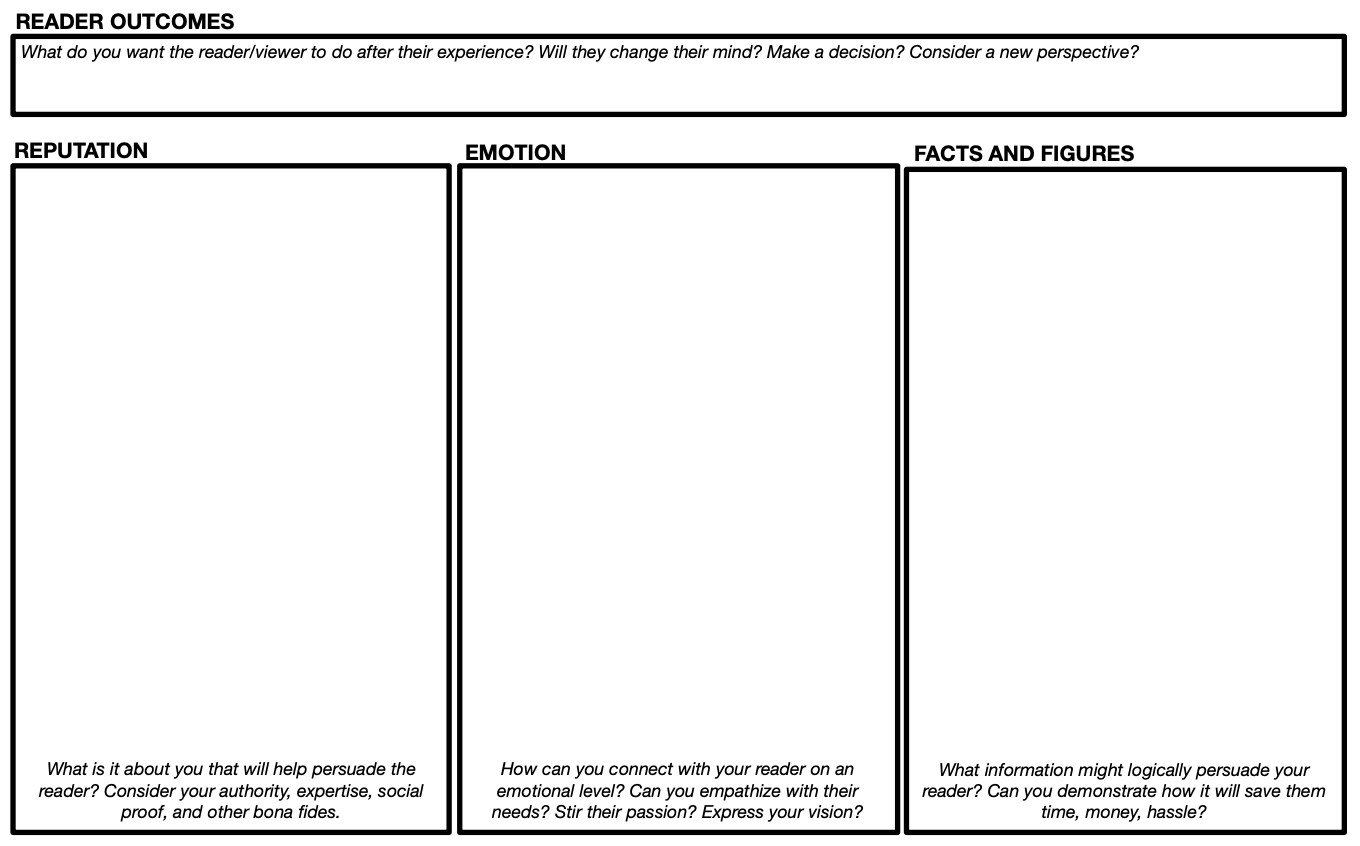Messaging Map
An ideation framework for product and brand positioning concepts, based on Aristotle’s three rhetorical appeals, which, for our purposes, are described as logic, emotion, and reputation.
Possible Applications
Develop concepts for marketing campaigns, or for individual communications. Reframe conversations when stakeholders are stuck on a single message / approach. Develop communications that will appeal to different audiences.
Related Ideas
rhetoric, marketing, advertising, messaging, brand strategy, product positioning
Need help with this tool?
Contact me to ask a question, inquire about training, or report an issue.

What It Is
The Messaging Map is a DIY tool for thinking that will help you generate ideas for messaging and rhetorical appeals for a given subject. It works well for product positioning, marketing campaigns, value proposition development, and similar.
It has three components:
- Logic (logical reasoning, facts and figures)
- Emotion (love, envy, FOMO, and all the rest)
- Reputation (trust and relationships, bona fides, social proof)
As you can see, this is a mostly-capitalist bastardization of the idea of rhetoric for marketing and communication purposes.
How It Works
“First thought = best thought” is rarely true for messaging and communications work, especially if the first thought was generated by an over-scheduled person (I’m SO busy!) lacking either familiarity with the subject or experience as a professional communicator.
Mapping out potential rhetorical appeals — methods of persuasion — for your messaging and campaigns creates visible proof that there are in fact many ways that you could communicate about a given topic. You are then able to foster conversation about which might be most effective overall, or which might work best for a given channel, audience, or communication format.
When used in your individual work and writing, the Messaging Map invites you to dig deeper and look for angles about the subject you might not have initially been inclined to consider. Emotional appeals aren’t always obvious for “dry” subjects, and reputational appeals aren’t always obvious for new things that don’t yet have their own reputation.
It also creates a “well” to return to for further ideas, and can be a deliverable given to a content or marketing team to boost their own ideation and creation work about the subject.
How To Use It
The Messaging Map is simply three prompts to map ideas to. This means you can use it in just about any tool that you and your team are comfortable with.
You can recreate these prompts as three branches of a mindmap (my preference), as three columns on a whiteboard, with three colors of sticky notes, with three headings in a Google document … whatever works for your need.
Often, someone will have already suggested an appeal, which may be what prompted this exercise in the first place. Capture that right away, then facilitate further ideation with the prompts.
Specific facts and figures, or specific quotes from specific individuals for your bona fides, aren’t always available in this moment. Use placeholders for the specifics, and capture the general sentiment instead.
This is generally a short exercise. You could run it in as little as 15 minutes with a group of writers familiar with the technique. More typically, you’ll want to organize a 30- or 45-minute agenda item or stand-alone workshop. An example Messaging Mapping workshop:
- 5 minutes | Introduce activity, explain each category with a different but familiar example — the appeals of going to Disneyland, or buying an iPhone, or choosing to recycle — and answer questions
- 5 minutes | First thoughts. Ask everyone to add two ideas to each column. They can do this in any order.
- 2-3 minutes | Invite questions; participants may need clarifications about the categories. Remind them that the ideas matter more than the exercise, and the categorization doesn’t need to be perfect. (For instance: messages including facts and figures often “feel” like logic, but are in fact reputational appeals; e.g. X-thousand of customers already love it.)
- 5 & 5 cycles, or 3 & 3 | Repeat ideation in 3 or 5 minute chunks, with 3 or 5 minutes of discussion and review in between. Invite participants to self-identify and group related ideas, or collapse identical ideas together. If ideas lag in a particular category, invite discussion around that, why it’s hard, what other avenues you might draw from, then run a single timed session focused on that category.
- 5-10 minutes | Dot voting. Give each participant 2 dots to vote for concepts in each category, or perhaps 2 dots in total if you have a larger group.
- 5-10 minutes | Closing reflection. Invite discussion of any concerns or reservations participants might have about concepts that have received votes. Invite anyone who voted for a concept with few other votes to talk about their choice / make a case for it. Explain next steps, thank everyone for their time.